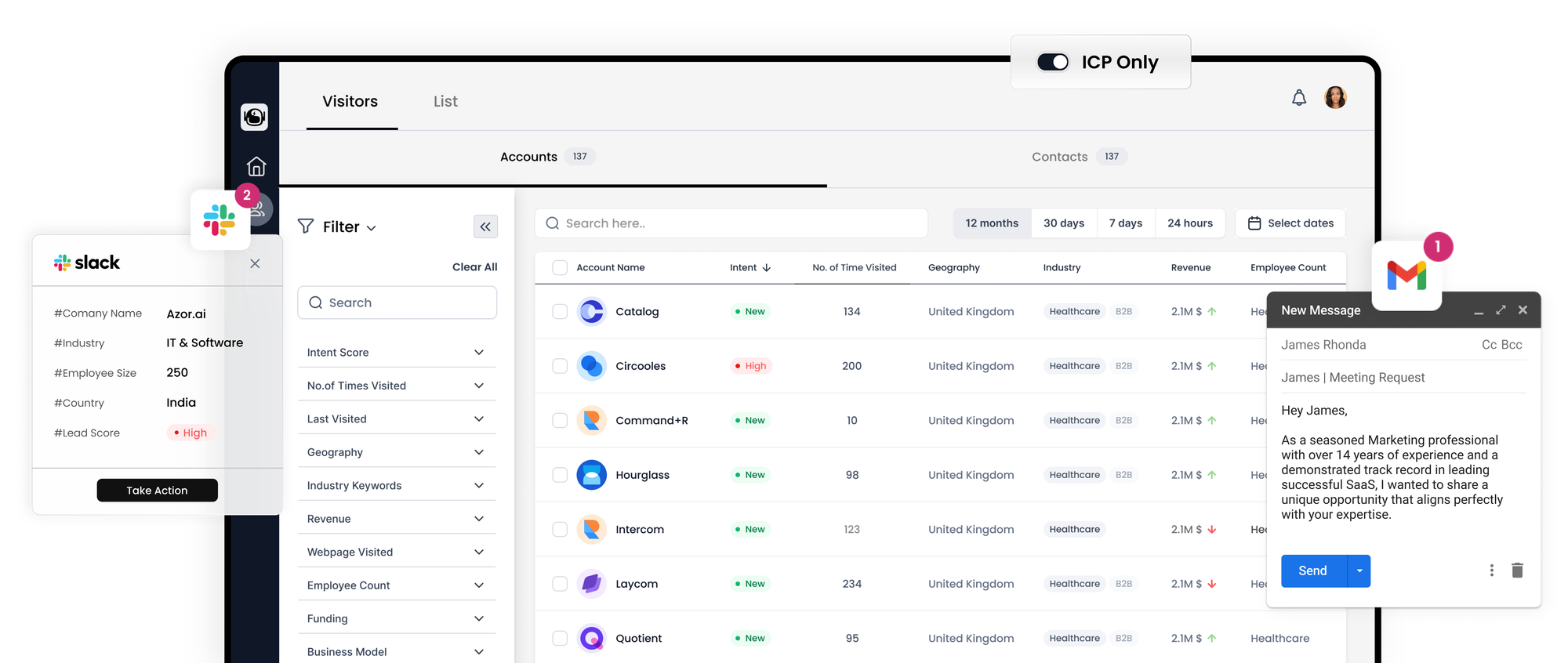7 Effective Tactics for Account-Based Marketing (ABM) to Enhance B2B Sales

The successful implementation of appropriate account-based marketing tactics is pivotal in engaging with today's B2B buyers. From utilizing video to employing physical gifts, we'll explore the foremost ABM tactics designed to captivate the attention of your prospects.
Business buyers now anticipate a higher degree of personalization compared to ordinary consumers. However, tailoring marketing endeavors can pose challenges, particularly when decision-makers are not individuals but rather groups. This is precisely where the significance of account-based marketing tactics becomes evident.
In this article, we will delve into seven highly effective account-based marketing tactics that can empower B2B enterprises to elevate their sales figures and bolster engagement.

Defining Account-Based Marketing (ABM)
Account-based marketing (ABM) constitutes a strategic approach in which B2B marketing endeavors are concentrated on meticulously selected accounts that align with the business's objectives. Commonly referred to as key account marketing, ABM necessitates close alignment between the marketing and sales teams to pinpoint and directly market to specific individual organizations that align with the ideal customer profile (ICP).
ABM incorporates an array of 'outbound' tactics aimed at stimulating interest from the ICP. These tactics encompass targeted advertising, direct mail campaigns, video prospecting, and social selling.
B2B account-based marketing is categorized into three primary types:
1. One-to-One (or "Strategic ABM")
This approach concentrates on singular, high-value accounts and entails highly personalized engagement efforts.
2. One-to-Few
Lower-tier accounts with comparable challenges and needs are the target here, with outreach customized to address these shared characteristics.
3. One-to-Many (or "Programmatic" ABM)
This variant targets larger groups of accounts based on more generalized criteria, such as size or industry, with customization that touches upon one shared characteristic.
Notably, one-to-one ABM necessitates the most significant commitment of time and resources, whereas one-to-many ABM demands the least. The choice among these approaches should be guided by the level of commitment you can allocate to your account-based marketing framework, with goals set accordingly.
Three Pillars of ABM
When devising your account-based marketing strategy, it's imperative to consider the three fundamental pillars of ABM:
1. Targeting
Account-based marketing inverts the conventional marketing funnel paradigm. Instead of casting a wide net and hoping to ensnare leads, ABM centers on identifying and directing efforts toward specific high-value accounts with the highest conversion potential. An in-depth comprehension of your ideal customer profile (ICP) is essential, necessitating close collaboration with your sales team to ascertain which accounts merit pursuit. Leveraging advanced data analytics and predictive modeling is instrumental in this endeavor, allowing you to filter accounts based on criteria such as industry, company size, prior engagement, and more. This precision in targeting ensures that your efforts are concentrated on accounts with the utmost potential for success.
2. Content
Once you have pinpointed your target accounts, the second pillar of ABM comes into play: content. Personalization constitutes the cornerstone of an effective ABM strategy, extending beyond merely addressing prospects by their first names. It encompasses the delivery of content and messaging that deeply resonates with the specific challenges, pain points, and objectives of each account. Crafting personalized content can be resource-intensive, yet it is an investment that yields substantial returns. Tailored emails, case studies, webinars, and even one-on-one interactions serve to render your message more pertinent and engaging. By demonstrating a keen understanding of their distinct requirements, you heighten the likelihood of capturing their attention and establishing a meaningful connection.
3. Continuity
The ultimate pillar of a triumphant account-based marketing plan is continuity. ABM is not characterized by a one-and-done approach; rather, it revolves around nurturing and perpetuating relationships with your target accounts over time. This necessitates a consistent and well-coordinated effort between your marketing and sales teams. Continuity entails remaining top-of-mind with your accounts, even when immediate purchasing decisions are not imminent. Regular touchpoints, personalized follow-ups, and sustained engagement assume paramount significance. Building trust and credibility is an iterative process, and continuity ensures that your accounts perceive your brand as a dependable partner capable of addressing their evolving needs.
Assessing the Effectiveness of ABM
Adhering to best practices in account-based marketing may appear to entail significant effort, but the rewards it offers are substantial. The advantages of ABM include the following:
1. 87% of B2B marketers affirm that ABM delivers a higher return on investment (ROI).
2. Companies implementing ABM witness a remarkable 171% increase in average annual contract value.
3. A resounding 96% of surveyed marketers acknowledge that ABM has a positive impact on their overall success.
4. Among marketing teams utilizing ABM for a minimum of one year, 60% report a significant boost in revenue.
5. A striking 70% of ABM users assert that their marketing and sales teams exhibit a high degree of alignment, whereas only 51% of organizations not employing ABM can make the same claim.
This compelling data underscores the pivotal role of ABM in modern B2B marketing, emphasizing the imperative for businesses not to lag behind in adopting this strategy.
7 Account-Based Marketing Tactics for B2B Entities
Embarking on your own account-based marketing framework requires a strategic approach, and we have compiled a selection of seven effective tactics for your consideration, replete with account-based marketing examples to spark your creativity.
Select a few of these proven account-based marketing tactics that align with your business objectives and put them into practice.
1. Customize Content Topics to Address Target Audience Needs
Whether you are crafting blog posts, webinars, eBooks (or video books), or guides, selecting content topics that resonate with the pain points and requirements of your target accounts is an efficacious method for capturing their interest. Instead of employing generic topics, delve into specifics that you know are of utmost concern to your most critical prospects. In your targeted strategies, endeavor to address the query, "How can I assist?" Concentrating on the direct needs of accounts conforming to your ideal customer profile (ICP) will optimize your chances of securing key accounts. In this context, quality takes precedence over quantity.
2. Segment and Utilize Your Data
If your organization generates original data for the creation of reports and other content, this data can be a valuable asset for your ABM endeavors. When creating extensive reports, contemplate how to segment the data and repurpose it to tailor it to a specific account. Take your primary report or asset, extract and repackage statistics pertinent to specific industries, company sizes, maturity levels, and more. This approach not only proves effective in your ABM initiatives but also maximizes the value derived from your data.
3. Harness the Power of Video for Enhanced Engagement
Video is a versatile tool that can significantly amplify your ABM framework. Personalization lies at the core of account-based marketing tactics, and sending a direct video message to a prospect is an exceedingly personal approach. It rapidly establishes a face-to-name connection and fosters trust with the target account. Video can be incorporated into email and newsletter campaigns to introduce your brand to cold leads, delivering higher engagement scores compared to text-based emails. Screen share videos provide a unique means to guide prospects through ideas, products, or websites while referencing known pain points that your offerings can address. Personalized videos, created in a selfie-style format, further enhance the personal touch by featuring the prospect's name or customized messages. Additionally, account-level personalized videos maintain a sense of customization while offering scalability for dissemination to all individuals within the account.
4. Tier Customer Testimonials
There are ample opportunities to tailor customer testimonials to make the content relevant to targeted accounts. Begin by creating core testimonials that focus on common use cases for your product and can be shared broadly. Subsequently, craft customer stories customized for specific market segments or key accounts. In cases where high-production video shoots for testimonials are not feasible, consider involving customers in recording their own videos. This approach enables you to share dynamic video content that complements written narratives without exceeding budget constraints.
5. Develop Explainer and Thought Leadership Videos
To achieve optimal results when employing account-based marketing tactics, aim to establish a library of video content. This parallels the library of blog posts that nurture programs can integrate or that sales teams can leverage. Explainer videos are particularly effective in an ABM context as they frequently address questions posed by customers or prospects. Similarly, thought leadership videos contribute to positioning your organization as an authority within the industry.
6. Elevate Engagement with Physical Gifts
For teams that have experienced success with direct mail campaigns, sending physical gifts to prospects represents an advanced approach. When executed effectively, this tactic fosters a connection with key accounts and generates buzz within the target company. The crucial factor is conducting thorough research to gain insight into the prospect's preferences, enabling the selection and dispatch of a gift tailored to their preferences. Personalized follow-ups can further enhance the impact of this gesture.
7. Target Key Accounts through Digital Advertising
As in any campaign, digital ads serve as a potent means of extending your reach. Digital ads enable you to convey your message to precisely the audience you wish to engage. Additionally, ads are highly measurable, enabling teams to track results and identify what is working and what requires adjustment. Data gleaned from ad campaigns empowers sales teams to prioritize their efforts and reach out to the right individuals at the opportune moments. Coordinating digital ads with other ABM tactics enhances their overall efficacy, as exemplified by the successful synergy between ads, tailored content, and personalized videos in certain instances.
In your quest to determine the ideal mix of account-based marketing tactics, consider how these tactics interplay with each other. The example of Allie Butters, Director of Marketing at Terminus, illustrates the complementary nature of ads with tailored content and personalized video, underscoring the importance of a cohesive approach in ABM.
